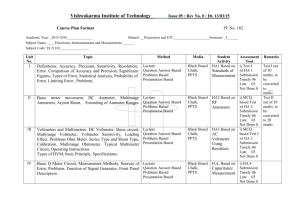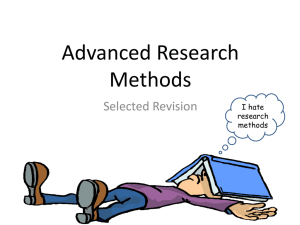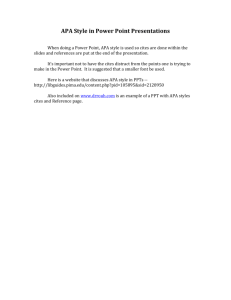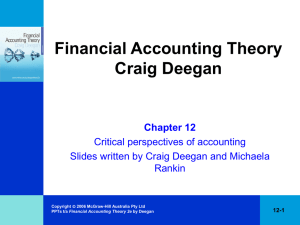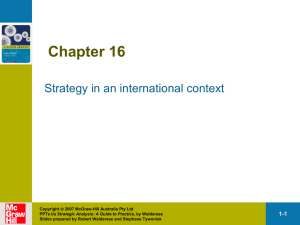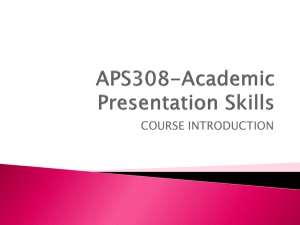Term 1: Endterm test (20%) Chapters 7, 8 and 9 preparation
advertisement
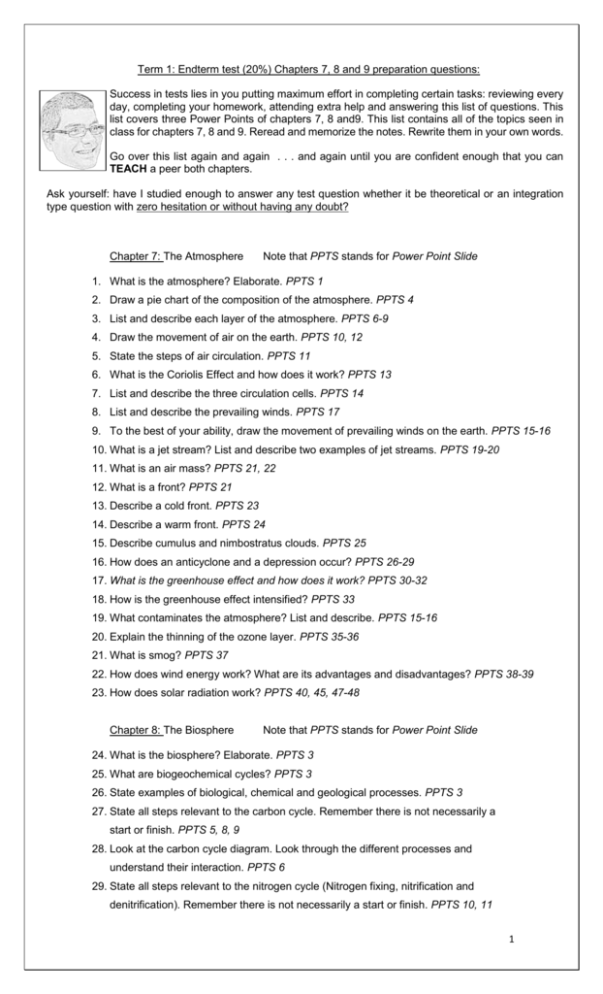
Term 1: Endterm test (20%) Chapters 7, 8 and 9 preparation questions: Success in tests lies in you putting maximum effort in completing certain tasks: reviewing every day, completing your homework, attending extra help and answering this list of questions. This list covers three Power Points of chapters 7, 8 and9. This list contains all of the topics seen in class for chapters 7, 8 and 9. Reread and memorize the notes. Rewrite them in your own words. Go over this list again and again . . . and again until you are confident enough that you can TEACH a peer both chapters. Ask yourself: have I studied enough to answer any test question whether it be theoretical or an integration type question with zero hesitation or without having any doubt? Chapter 7: The Atmosphere Note that PPTS stands for Power Point Slide 1. What is the atmosphere? Elaborate. PPTS 1 2. Draw a pie chart of the composition of the atmosphere. PPTS 4 3. List and describe each layer of the atmosphere. PPTS 6-9 4. Draw the movement of air on the earth. PPTS 10, 12 5. State the steps of air circulation. PPTS 11 6. What is the Coriolis Effect and how does it work? PPTS 13 7. List and describe the three circulation cells. PPTS 14 8. List and describe the prevailing winds. PPTS 17 9. To the best of your ability, draw the movement of prevailing winds on the earth. PPTS 15-16 10. What is a jet stream? List and describe two examples of jet streams. PPTS 19-20 11. What is an air mass? PPTS 21, 22 12. What is a front? PPTS 21 13. Describe a cold front. PPTS 23 14. Describe a warm front. PPTS 24 15. Describe cumulus and nimbostratus clouds. PPTS 25 16. How does an anticyclone and a depression occur? PPTS 26-29 17. What is the greenhouse effect and how does it work? PPTS 30-32 18. How is the greenhouse effect intensified? PPTS 33 19. What contaminates the atmosphere? List and describe. PPTS 15-16 20. Explain the thinning of the ozone layer. PPTS 35-36 21. What is smog? PPTS 37 22. How does wind energy work? What are its advantages and disadvantages? PPTS 38-39 23. How does solar radiation work? PPTS 40, 45, 47-48 Chapter 8: The Biosphere Note that PPTS stands for Power Point Slide 24. What is the biosphere? Elaborate. PPTS 3 25. What are biogeochemical cycles? PPTS 3 26. State examples of biological, chemical and geological processes. PPTS 3 27. State all steps relevant to the carbon cycle. Remember there is not necessarily a start or finish. PPTS 5, 8, 9 28. Look at the carbon cycle diagram. Look through the different processes and understand their interaction. PPTS 6 29. State all steps relevant to the nitrogen cycle (Nitrogen fixing, nitrification and denitrification). Remember there is not necessarily a start or finish. PPTS 10, 11 1 30. Look at the nitrogen cycle diagram. Look through the different processes and understand their interaction. PPTS 12 31. State all steps relevant to the phosphorus cycle. Remember there is not necessarily a start or finish. PPTS 14, 15 32. Look at the phosphorus cycle diagram. Look through the different processes and understand their interaction. PPTS 16, 17 33. Biomes. List factors that affect the distribution of biomes. PPTS 18 34. Terrestrial biome: tropical. Describe it: Where is it? What is average temperature? What threatens it? Elaborate. PPTS 22 35. Terrestrial biome: Boreal. Describe it: Where is it? What type of trees does it contain? What threatens it? Elaborate. PPTS 26, 29 36. Terrestrial biome: Temperate forests. Describe it: Where is it? What type of trees does it contain? What threatens it? Elaborate. PPTS 30 37. Terrestrial biome: Arctic tundra. Describe it: Where is it? What type of trees does it contain? What threatens it? Elaborate. PPTS 34 38. Terrestrial biome: Grasslands and Scrublands. Describe it: Where is it? How much rainfall does it receive? What are some of its distinctive features? How do the plants grow (root system)? Describe the three types: Temperate, Savannas and Derived grasslands. Elaborate. PPTS 36, 38 39. Terrestrial biome: Desserts. Describe it: Where is it? Water content, temperature variation, the moderating effect of water. Elaborate. PPTS 40, 42 40. Terrestrial biome: Alpine. Describe it: Where is it? Submontane, Montane, Subalpine and Nival zones. What is their vegetation? Elaborate. PPTS 43, 44, 46 41. Aquatic biome: Explain how they are distributed (Example: salt content). PPTS 47 42. Aquatic biome: Freshwater: Lakes. How do they vary? Living organisms? Threats? Lakeshore vegetation role (Buffer)? Elaborate. PPTS 49, 51 43. Aquatic biome: Freshwater: Rivers. What are they? Their species? Threats (Phosphorus and Watersheds, Quebec Water Policy) Elaborate. PPTS 51, 53 44. Aquatic biome: Freshwater: Wetlands. What are they (Marshes, swamps and peat bogs)? Prairie potholes and their importance? Elaborate. PPTS 54 45. Aquatic biome: Marine biomes: How are they distributed again? Elaborate. PPTS 56 46. Aquatic biome: Marine: Estuaries. What are they? Turbid? Species? Elaborate. PPTS 57 47. Aquatic biome: Marine: Oceans and seas. How are they distributed? Phytoplankton? Their fauna? Benthos? PPTS 59, 61 48. Aquatic biome: Marine: Coral reefs. Where are they found? How are they formed? What threatens them? PPTS 62, 63 Chapter 9: Population and Communities Note that PPTS stands for Power Point Slide 49. Studying populations. What is a population? How are they described? PPTS 2 50. What affects population size positively and negatively? What happens one negative outweighs the positive, or vice versa or equal proportions? PPTS 4, 6, 7 51. Methods for measuring the size of a population. Explain how they work (Counting individuals, Counting by sample area and MATH, Mark and recapture) PPTS 8, 9, 11, 12 2 Counting by sample area: Mark and recapture: 52. Population density. PPTS 15 53. Population distribution. Elaborate: Clumped, Uniform and Random. PPTS 17, 18, 19 54. Ecological factors. Describe the abiotic and biotic factors that affect individuals within a population. What is a limiting factor and how does affect the development of a population? State examples of these factors. PPTS 20, 22 55. What is a biological cycle in populations? Are you able to explain the diagram below to me? PPTS 23, 25, 26 Done! The rest is up to you. 3

